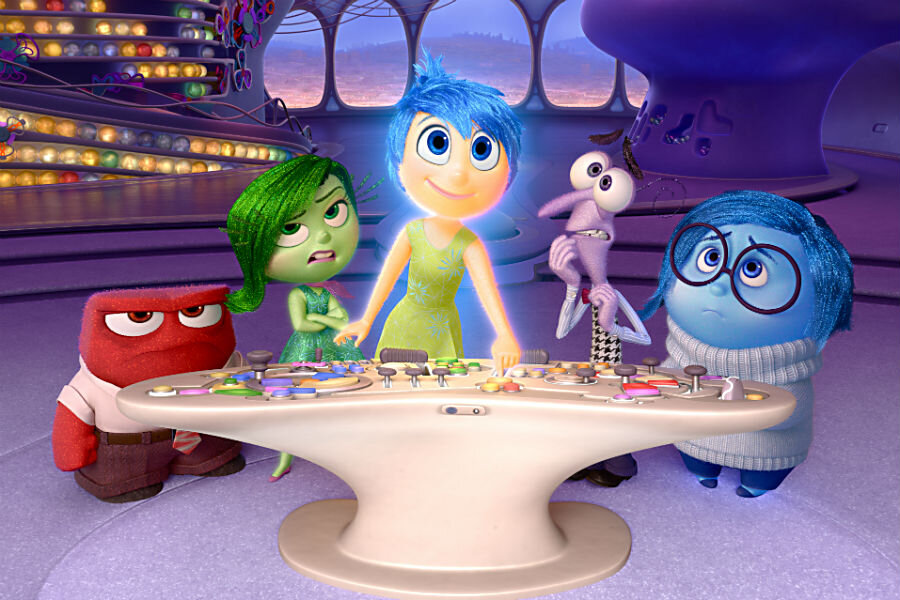'Inside Out': Disney film based on science of facial expressions
Loading...
The star in Disney's newest Pixar animated movie, "Inside Out," isn't a princess or a robot or a monster. It's really neuroscience. Journeying into the emotional control center of a young girl's mind, the film draws on psychological research to explore the science of emotions expressed.
The story centers on 11-year-old Riley, whose family has just moved from Minnesota to San Francisco, throwing her emotional life for a loop. So when Riley goes through standard adolescent frustrations – an argument with her parents, a rough day at school, a tough hockey tryout – viewers are seeing the science of facial expressions on the big screen.
How?
Drawing on the old literary tradition of turning "passions," or emotions, into characters, the film stars five personified emotions: Joy (voiced by Amy Poehler); Sadness (Phyllis Smith); Anger (Lewis Black); Fear (Bill Hader); and Disgust (Mindy Kaling), all of which are portrayed as operating from a control center inside Riley's head.
In the pursuit of veracity and to ensure that a global audience understood the emotions expressed, the film's director, Pete Doctor, consulted with psychologist Paul Ekman, the creator of facial coding, which measures and codes different facial expressions across cultures into a concrete set of emotions shared by humans.
Dr. Ekman's research indicates that there are six universal facial expressions that translate into six emotions: Happiness, Sadness, Fear, Surprise, Anger, and Disgust. (He later added a seventh emotion, Contempt.)
As The Christian Science Monitor reported, "These expressions are thought to have arisen from basic survival mechanisms. Widening the eyes in fear, for instance, might represent an effort to take in more visual information about the environment. And wrinkling the nose in disgust impedes breathing, possibly limiting the intake of toxins or pathogens."
The film's creators ultimately narrowed the list to five, eliminating "surprise," because that facial expression is similar to fear.
"We ended up at these five, largely because of the work of Dr. Paul Ekman, who was one of the consultants on the show," director Doctor told TK Geek Dad. "And he had originally, back in the ’70s, posited six. It was our five, plus surprise. And we felt surprise, as a cartoon, is probably fairly similar to fear. So we jettisoned that one, and that’s how we ended up with the five.”
"It felt like a good crowd, enough contrast and conflict between them, but not so big that you’re, like, ‘Wait, who’s that again? Schadenfreude? Okay. Lost track of…'"
Judging from early reviews, "Inside Out," which hits theaters Friday, has been well-received. That's no coincidence, says Roger Dooley, a neuromarketing expert.
"From its theme parks to its cruise ships, not to mention its media ventures, Disney has been uncommonly good at crafting emotional appeals that work," Dooley wrote in a recent Forbes piece.
The secret behind Pixar's success isn't only its lifelike animation, but it's ability to reflect real, human emotions. And Disney has a lab in Austin, Texas, that studies how consumers respond to visual messages. "One way they have done this is to employ a variety of neuromarketing (or consumer neuroscience, the term some prefer) technologies to gauge real consumer reactions [like] Disney’s Secret Austin Neuromarketing Lab...the firm’s under the radar effort to measure consumer emotions and behavior," wrote Dooley.
While it maintains an upbeat tone, unlike many children's animated films, "Inside Out," in keeping with its research, also fully explores the emotion of sadness, a decision that is in line with the latest science.
“It really tells us something very true and unique about emotional experience,” psychology professor Dacher Keltner of University of California, Berkeley, an expert in the study of emotions who consulted with Pixar on the film and saw an early screening, told the AP. “The film suggests that, in a way, all emotions have their purpose, and that is very much in line with the recent science.”
Poehler, who plays the emotion Joy, echoed Keltner's observation.
“We tell ourselves that the constant pursuit of happiness is what we need to do, and if you’re not doing it, you’re doing something wrong,” she said. “Instead, this big concept of feeling your feelings and trying to stay true to who you are and what you want, that’s the journey. That’s life, man!”






